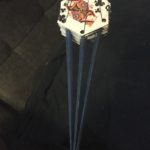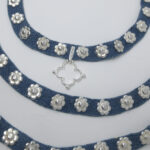A silk belt
Hold on, you are not on the blog of my dear friend and colleague Niklas, der Girdler! No, this time, I will tell you about this belt myself, even if Nikolaus did have his fair share to do with this piece.
My impression of a wealthy crafters wife is slowly but surely being finalised. One large project that I had postponed for a long time and which I was working on for far too long, is finally finished. A belt suitable for this ensemble.
A bit of theory. Here you can find several original finds of belts from the middle ages. If you want to reconstruct a late medieval belt, you absolutely need to look at the Erfurt treasury find, the Wiener Neustadt Treasury find and the Colmar treasury find for inspiration. The latter includes this very pretty example here which was guiding my aesthetic for this belt.
Regarding the length, I consulted different originals but also illuminations and statues. It really isn’t easy to find an example where all the details are clearly visible, especially the length, because so many belts disappear underneath surcoats or in the folds of dresses.
Here is f.e. a nice example from the Biblia Pauperum von 1330-40
Here is another example with a double wrapped belt from 1370 Slovakia
or this example from the Codex Manesse and again
Here you see a lot of belts on original effigies
This example here is from Spain around 1330-40 which is far away from my region, but shows a lot of lenght
In the church Thunau am Kamp you can find this beautiful example from the 1330s.
And here is another example from France with a light loop.
As for textual sources I chose german ones because they fit my region better. You can read them in the german version of this article if you are interested and fit in middle high german.
The realisation: I had ordered 120 silvered belt mounts already in 2019, the concrete motive is from a find from London, but flower motives are pretty universally found and liked in the 14th century. I also ordered a fitting purse hanger and a pretty average buckle. (For some light reading on belts and buckles I recommend some of the works mentionned here)
While I was waiting for my order, I had to think about which material the belt should be. I wanted at least 2.5 meters of length, because I have a pretty voluminous body and the belt was supposed to reach the ground or even be longer than that so I could wind it around the hip more than once as can be seen in some depictions. For the mounts, I estimated it would have to be about 1.5 cm wide.
And usually, in a class like my wealthy crafters wife is in, a tablet woven silk belt would be standard for a representational piece. But I could absolutely not afford having a piece like this custom woven for me. So I begrudgingly decided that it would have to be done by myself. So I ordered indigo dyed silk yarn from Marled Mader and Silvia Ungerechts gave me – as usual – the necessary tips to get the pattern going. I chose a pattern from the Erfurter treasuries, where the original belts offer a variety of patterns, one very interesting one with hexagonal tablets and a double-weft. Weaving this structure has taken for-fucking-ever which I had not expected after I had some light experience with other tablet weaving works. Alltogether, it took me 30 hours just for the weaving.
Next, I hammered the mounts on in about 2 cm margins as can be seen on original belts. I really wanted to learn to do this myself and after some struggling at the beginning, where two professionals helped me greatly (thank you Nikolaus and Christian!), it finally clicked and the mounts were on the belt pretty quickly I have to say.
When it came to the belt end and buckle plates, I let the professional do it and gave the work to my friend Nikolaus who did some amazing work with it. He engraved the belt end plate with “Amor Vincit Omnia (AVO)” and the buckle plate with my dog Socke (in the style of a medieval illumination) . Amor Vincit Omnia is a very well known proverb in late medieval times which goes back to the works of Vergil and it means “Love conquers all” and it can be found written or just as a shortened AVO on jewellery and lovers gifts of the time. The dog is a medieval symbol for loyalty and friendship.
On the side at the front of the belt when it is wound, I adjusted the purse hanger, a simple quatrefoil shape, also very common in this time.
I did not line the belt with silk fabric although that would be a possibility. But there is too many examples already in the scene which are lined and we need some unlined examples represented as well.
And this is the belt as a whole. I am very proud of it and satisfied with how it turned out and that it really does touch the ground when I wear it. I will show you the belt worn with my ensemble, but I want the ensemble to be ready first. Soon, very soon!
Related Posts
The following posts might interest you as well:




















